
Write structural formulas for the following compounds.
- (a) C2H4Br2: δ 2.5 (d, 3H) and 5.9 (q, 1H)
- (b) C4HgCl2: δ 1.60 (d, 3H), 2.15 (m, 2H), 3.72 (t, 2H), and 4.27 (m, 1H)
- (c) C5H8Br4: δ 3.6 (s, 8H)
- (d) C4H8O: δ 1.0 (t, 3H), 2.1 (s, 3H), and 2.4 (quartet, 2H)
- (e) C4H8O2: δ 1.2 (t, 3H), 2.1 (s, 3H), and 4.1 (quartet, 2H); contains an ester
- (f) C4H8O2: δ 1.2 (t, 3H), 2.3 (quartet, 2H), and 3.6 (s, 3H); contains an ester
- (g) C4H9Br: δ 1.1 (d, 6H), 1.9 (m, 1H), and 3.4 (d, 2H)
- (h) C6H12O2: δ 1.5 (s, 9H) and 2.0 (s, 3H)
- (i) C7H14O: δ 0.9 (t, 6H), 1.6 (sextet, 4H), and 2.4 (t, 4H)
- (j) C5H10O2: δ 1.2 (d, 6H), 2.0 (s, 3H), and 5.0 (septet, 1H)
- (k) C5H11Br: δ 1.1 (s, 9H) and 3.2 (s, 2H)
- (l) C7H15Cl δ 1.1 (s, 9H) and 1.6 (s, 6H)
(a)
Interpretation:
The structural formula of the given compound has to be proposed with the help of given molecular formula and its
Concept introduction:
The
Chemical shift: The NMR spectrum of any compound is taken with reference to a standard compound called reference compound. Generally, tetramethylsilane (TMS) is taken as the reference compound. The methyl protons of TMS are equivalent and produces only one sharp peak at the rightmost end of the scale.
The distance between the TMS signal and the signals produced by the compound is called the chemical shift. Chemical shift basically measures the shift in the signal position of the compound with respect to the reference signal.
Chemical shift in delta scale is given as,
Explanation of Solution
The given molecular formula (a) is
There are 2 peaks observed in the given
A doublet is observed for 3 hydrogens at around
Another quartet peak for 1 hydrogen at around
Based on the above
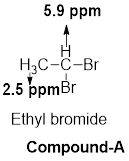
(b)
Interpretation:
The structural formula of the given compound has to be proposed with the help of given molecular formula and its
Concept introduction:
The
Chemical shift: The NMR spectrum of any compound is taken with reference to a standard compound called reference compound. Generally, tetramethylsilane (TMS) is taken as the reference compound. The methyl protons of TMS are equivalent and produces only one sharp peak at the rightmost end of the scale.
The distance between the TMS signal and the signals produced by the compound is called the chemical shift. Chemical shift basically measures the shift in the signal position of the compound with respect to the reference signal.
Chemical shift in delta scale is given as,
Explanation of Solution
The given molecular formula (b) is
A doublet is observed for 3 hydrogens at around
A multiplet is observed for 2 hydrogens at around
One triplet peak is observed for 2 hydrogens at around
Another multiplet is observed for 1 hydrogen at around
Thus, the structure of the compound (b) is 1,3-dichlorobutane:
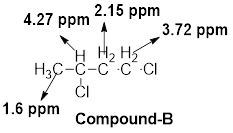
(c)
Interpretation:
The structural formula of the given compound has to be proposed with the help of given molecular formula and its
Concept introduction:
The
Chemical shift: The NMR spectrum of any compound is taken with reference to a standard compound called reference compound. Generally, tetramethylsilane (TMS) is taken as the reference compound. The methyl protons of TMS are equivalent and produces only one sharp peak at the rightmost end of the scale.
The distance between the TMS signal and the signals produced by the compound is called the chemical shift. Chemical shift basically measures the shift in the signal position of the compound with respect to the reference signal.
Chemical shift in delta scale is given as,
Explanation of Solution
The given molecular formula (c) is
This molecule only one singlet is observed for 8 hydrogens at around
Therefore, the structure of the compound (c) is given below and this molecule symmetrical.
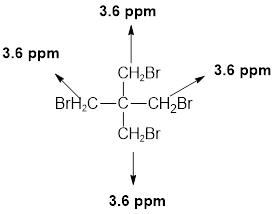
(d)
Interpretation:
The structural formula of the given compound has to be proposed with the help of given molecular formula and its
Concept introduction:
The
Chemical shift: The NMR spectrum of any compound is taken with reference to a standard compound called reference compound. Generally, tetramethylsilane (TMS) is taken as the reference compound. The methyl protons of TMS are equivalent and produces only one sharp peak at the rightmost end of the scale.
The distance between the TMS signal and the signals produced by the compound is called the chemical shift. Chemical shift basically measures the shift in the signal position of the compound with respect to the reference signal.
Chemical shift in delta scale is given as,
Explanation of Solution
The given molecular formula (d) is
A triplet is observed for 3 hydrogens at around
One singlet is observed for 3 hydrogens at around
Another quartet is observed for 2 hydrogens at around
Thus, the structure of the compound (d) is,
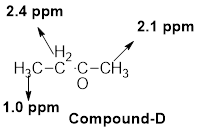
(e)
Interpretation:
The structural formula of the given compound has to be proposed with the help of given molecular formula and its
Concept introduction:
The
Chemical shift: The NMR spectrum of any compound is taken with reference to a standard compound called reference compound. Generally, tetramethylsilane (TMS) is taken as the reference compound. The methyl protons of TMS are equivalent and produces only one sharp peak at the rightmost end of the scale.
The distance between the TMS signal and the signals produced by the compound is called the chemical shift. Chemical shift basically measures the shift in the signal position of the compound with respect to the reference signal.
Chemical shift in delta scale is given as,
Explanation of Solution
The given molecular formula (e) is
A triplet is observed for 3 hydrogens at around
One singlet is observed for 3 hydrogens at around
Another quartet is observed for 2 hydrogens at around
Thus, the structure of the compound (e) is,
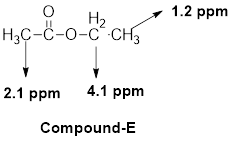
(f)
Interpretation:
The structural formula of the given compound has to be proposed with the help of given molecular formula and its
Concept introduction:
The
Chemical shift: The NMR spectrum of any compound is taken with reference to a standard compound called reference compound. Generally, tetramethylsilane (TMS) is taken as the reference compound. The methyl protons of TMS are equivalent and produces only one sharp peak at the rightmost end of the scale.
The distance between the TMS signal and the signals produced by the compound is called the chemical shift. Chemical shift basically measures the shift in the signal position of the compound with respect to the reference signal.
Chemical shift in delta scale is given as,
Explanation of Solution
The given molecular formula (f) is
A triplet is observed for 3 hydrogens at around
One singlet is observed for 3 hydrogens at around
Another quartet is observed for 2 hydrogens at around
Thus, the structure of the compound (f) is,
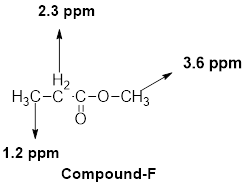
(g)
Interpretation:
The structural formula of the given compound has to be proposed with the help of given molecular formula and its
Concept introduction:
The
Chemical shift: The NMR spectrum of any compound is taken with reference to a standard compound called reference compound. Generally, tetramethylsilane (TMS) is taken as the reference compound. The methyl protons of TMS are equivalent and produces only one sharp peak at the rightmost end of the scale.
The distance between the TMS signal and the signals produced by the compound is called the chemical shift. Chemical shift basically measures the shift in the signal position of the compound with respect to the reference signal.
Chemical shift in delta scale is given as,
Explanation of Solution
The given molecular formula (g) is
A doublet is observed for 6 hydrogens at around
One multiplet is observed for 1 hydrogen at around
Another multiplet is observed for 2 hydrogens at around
Thus, the structure of the compound (g) is,
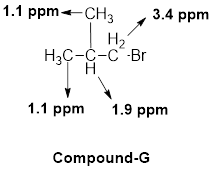
(h)
Interpretation:
The structural formula of the given compound has to be proposed with the help of given molecular formula and its
Concept introduction:
The
Chemical shift: The NMR spectrum of any compound is taken with reference to a standard compound called reference compound. Generally, tetramethylsilane (TMS) is taken as the reference compound. The methyl protons of TMS are equivalent and produces only one sharp peak at the rightmost end of the scale.
The distance between the TMS signal and the signals produced by the compound is called the chemical shift. Chemical shift basically measures the shift in the signal position of the compound with respect to the reference signal.
Chemical shift in delta scale is given as,
Explanation of Solution
The given molecular formula (h) is
A singlet is observed for 9 hydrogens at around
Another one singlet is observed for 3 hydrogens at around
Thus, the structure of the compound (h) is,

(i)
Interpretation:
The structural formula of the given compound has to be proposed with the help of given molecular formula and its
Concept introduction:
The
Chemical shift: The NMR spectrum of any compound is taken with reference to a standard compound called reference compound. Generally, tetramethylsilane (TMS) is taken as the reference compound. The methyl protons of TMS are equivalent and produces only one sharp peak at the rightmost end of the scale.
The distance between the TMS signal and the signals produced by the compound is called the chemical shift. Chemical shift basically measures the shift in the signal position of the compound with respect to the reference signal.
Chemical shift in delta scale is given as,
Explanation of Solution
The given molecular formula (i) is
A singlet is observed for 6 hydrogens at around
One sextet is observed for 4 hydrogens at around
Another triplet peak for 4 hydrogens at around
Thus, the structure of the compound (i) is,
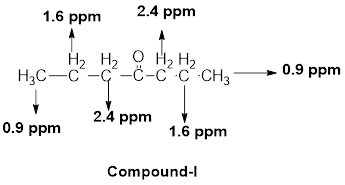
(j)
Interpretation:
The structural formula of the given compound has to be proposed with the help of given molecular formula and its
Concept introduction:
The
Chemical shift: The NMR spectrum of any compound is taken with reference to a standard compound called reference compound. Generally, tetramethylsilane (TMS) is taken as the reference compound. The methyl protons of TMS are equivalent and produces only one sharp peak at the rightmost end of the scale.
The distance between the TMS signal and the signals produced by the compound is called the chemical shift. Chemical shift basically measures the shift in the signal position of the compound with respect to the reference signal.
Chemical shift in delta scale is given as,
Explanation of Solution
The given molecular formula (J) is
A doublet is observed for 6 hydrogens at around
One septet is observed for 1 hydrogen at around
Another singlet peak for 3 hydrogens at around
Thus, the structure of the compound (J) is,
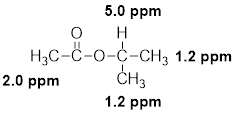
(k)
Interpretation:
The structural formula of the given compound has to be proposed with the help of given molecular formula and its
Concept introduction:
The
Chemical shift: The NMR spectrum of any compound is taken with reference to a standard compound called reference compound. Generally, tetramethylsilane (TMS) is taken as the reference compound. The methyl protons of TMS are equivalent and produces only one sharp peak at the rightmost end of the scale.
The distance between the TMS signal and the signals produced by the compound is called the chemical shift. Chemical shift basically measures the shift in the signal position of the compound with respect to the reference signal.
Chemical shift in delta scale is given as,
Explanation of Solution
The given molecular formula (K) is
A singlet is observed for 9 hydrogens at around
One singlet is observed for 2 hydrogens at around
Thus, the structure of the compound (K) is,
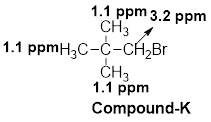
(l)
Interpretation:
The structural formula of the given compound has to be proposed with the help of given molecular formula and its
Concept introduction:
The
Chemical shift: The NMR spectrum of any compound is taken with reference to a standard compound called reference compound. Generally, tetramethylsilane (TMS) is taken as the reference compound. The methyl protons of TMS are equivalent and produces only one sharp peak at the rightmost end of the scale.
The distance between the TMS signal and the signals produced by the compound is called the chemical shift. Chemical shift basically measures the shift in the signal position of the compound with respect to the reference signal.
Chemical shift in delta scale is given as,
Explanation of Solution
The given molecular formula (L) is
A singlet is observed for 9 hydrogens at around
One singlet is observed for 6 hydrogens at around
Thus, the structure of the compound (L) is,
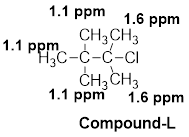
Want to see more full solutions like this?
Chapter 13 Solutions
ORGANIC CHEMISTRY-OWL V2 ACCESS
Additional Science Textbook Solutions
Campbell Biology (11th Edition)
Biology: Life on Earth with Physiology (11th Edition)
General, Organic, and Biological Chemistry - 4th edition
Physics for Scientists and Engineers: A Strategic Approach, Vol. 1 (Chs 1-21) (4th Edition)
Physics of Everyday Phenomena
- Draw the product of the reaction shown below. Ignore inorganic byproducts. + H CH3CH2OH HCI Drawingarrow_forwardplease explain this in simple termsarrow_forwardK Most Reactive Na (3 pts) Can the metal activity series (shown on the right) or a standard reduction potential table explain why potassium metal can be prepared from the reaction of molten KCI and Na metal but sodium metal is not prepared from the reaction of molten NaCl and K metal? Show how (not). Ca Mg Al с Zn Fe Sn Pb H Cu Ag Au Least Reactivearrow_forward
- (2 pts) Why is O2 more stable as a diatomic molecule than S2?arrow_forwardDraw the Lewis structure for the polyatomic phosphite (PO¾³¯) a anion. Be sure to include all resonance structures that satisfy the octet rule. C I A [ ]¯arrow_forwardDecide whether these proposed Lewis structures are reasonable. proposed Lewis structure Is the proposed Lewis structure reasonable? Yes. :0: Cl C C1: 0=0: : 0 : : 0 : H C N No, it has the wrong number of valence electrons. The correct number is: ☐ No, it has the right number of valence electrons but doesn't satisfy the octet rule. The symbols of the problem atoms are:* ☐ Yes. No, it has the wrong number of valence electrons. The correct number is: ☐ No, it has the right number of valence electrons but doesn't satisfy the octet rule. The symbols of the problem atoms are:* Yes. ☐ No, it has the wrong number of valence electrons. The correct number is: ☐ No, it has the right number of valence electrons but doesn't satisfy the octet rule. The symbols of the problem atoms are:* | * If two or more atoms of the same element don't satisfy the octet rule, just enter the chemical symbol as many times as necessary. For example, if two oxygen atoms don't satisfy the octet rule, enter "0,0".arrow_forward
- Draw the Lewis structure for the polyatomic trisulfide anion. Be sure to include all resonance structures that satisfy the octet rule. с [ ] - Garrow_forward1. Calculate the accurate monoisotopic mass (using all 1H, 12C, 14N, 160 and 35CI) for your product using the table in your lab manual. Don't include the Cl, since you should only have [M+H]*. Compare this to the value you see on the LC-MS printout. How much different are they? 2. There are four isotopic peaks for the [M+H]* ion at m/z 240, 241, 242 and 243. For one point of extra credit, explain what each of these is and why they are present. 3. There is a fragment ion at m/z 184. For one point of extra credit, identify this fragment and confirm by calculating the accurate monoisotopic mass. 4. The UV spectrum is also at the bottom of your printout. For one point of extra credit, look up the UV spectrum of bupropion on Google Images and compare to your spectrum. Do they match? Cite your source. 5. For most of you, there will be a second chromatographic peak whose m/z is 74 (to a round number). For one point of extra credit, see if you can identify this molecule as well and confirm by…arrow_forwardPlease draw, not just describe!arrow_forward
- can you draw each step on a piece of a paper please this is very confusing to mearrow_forward> Can the molecule on the right-hand side of this organic reaction be made in good yield from no more than two reactants, in one step, by moderately heating the reactants? esc ? A O O •If your answer is yes, then draw the reactant or reactants in the drawing area below. You can draw the reactants in any arrangement you like. • If your answer is no, check the box under the drawing area instead. olo 18 Ar Explanation Check BB Click and drag to start drawing a structure. 2025 McGraw Hill LLC. All Rights Reserved. Terms of Use | Privacy Center Accessibilityarrow_forwardName the structurearrow_forward
 Chemistry: The Molecular ScienceChemistryISBN:9781285199047Author:John W. Moore, Conrad L. StanitskiPublisher:Cengage Learning
Chemistry: The Molecular ScienceChemistryISBN:9781285199047Author:John W. Moore, Conrad L. StanitskiPublisher:Cengage Learning Chemistry by OpenStax (2015-05-04)ChemistryISBN:9781938168390Author:Klaus Theopold, Richard H Langley, Paul Flowers, William R. Robinson, Mark BlaserPublisher:OpenStax
Chemistry by OpenStax (2015-05-04)ChemistryISBN:9781938168390Author:Klaus Theopold, Richard H Langley, Paul Flowers, William R. Robinson, Mark BlaserPublisher:OpenStax

